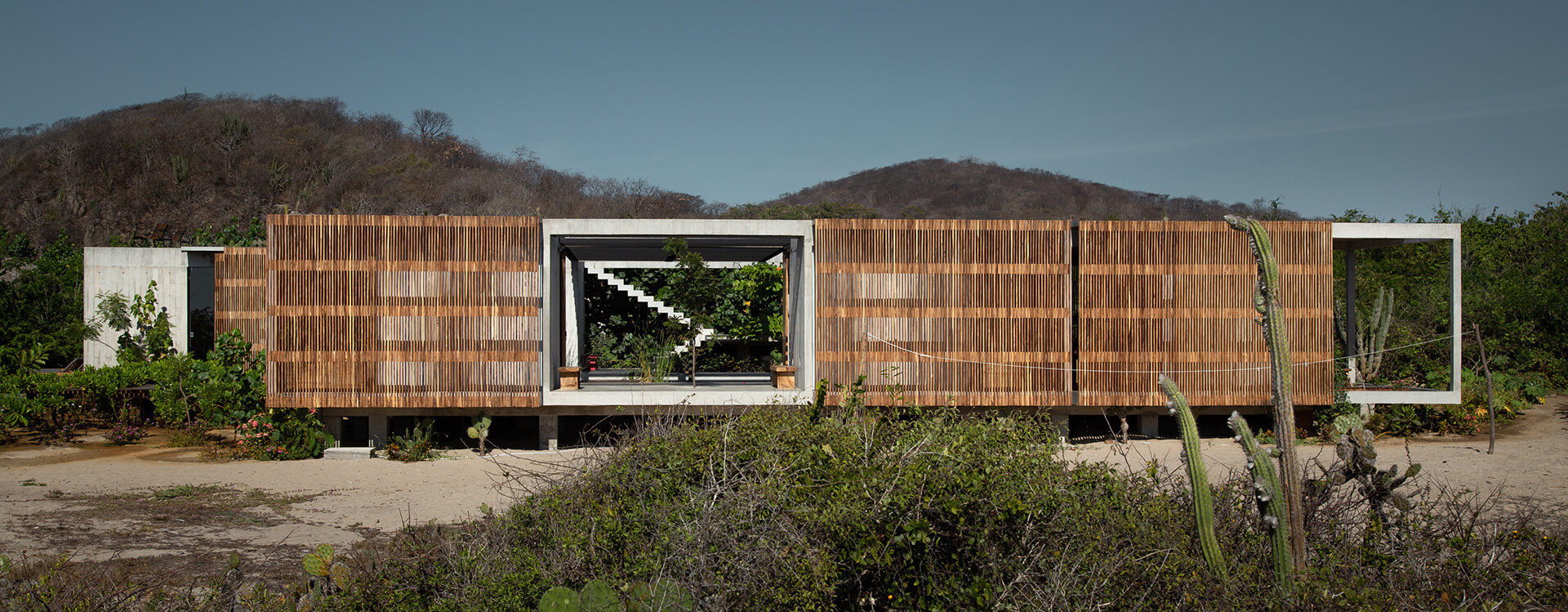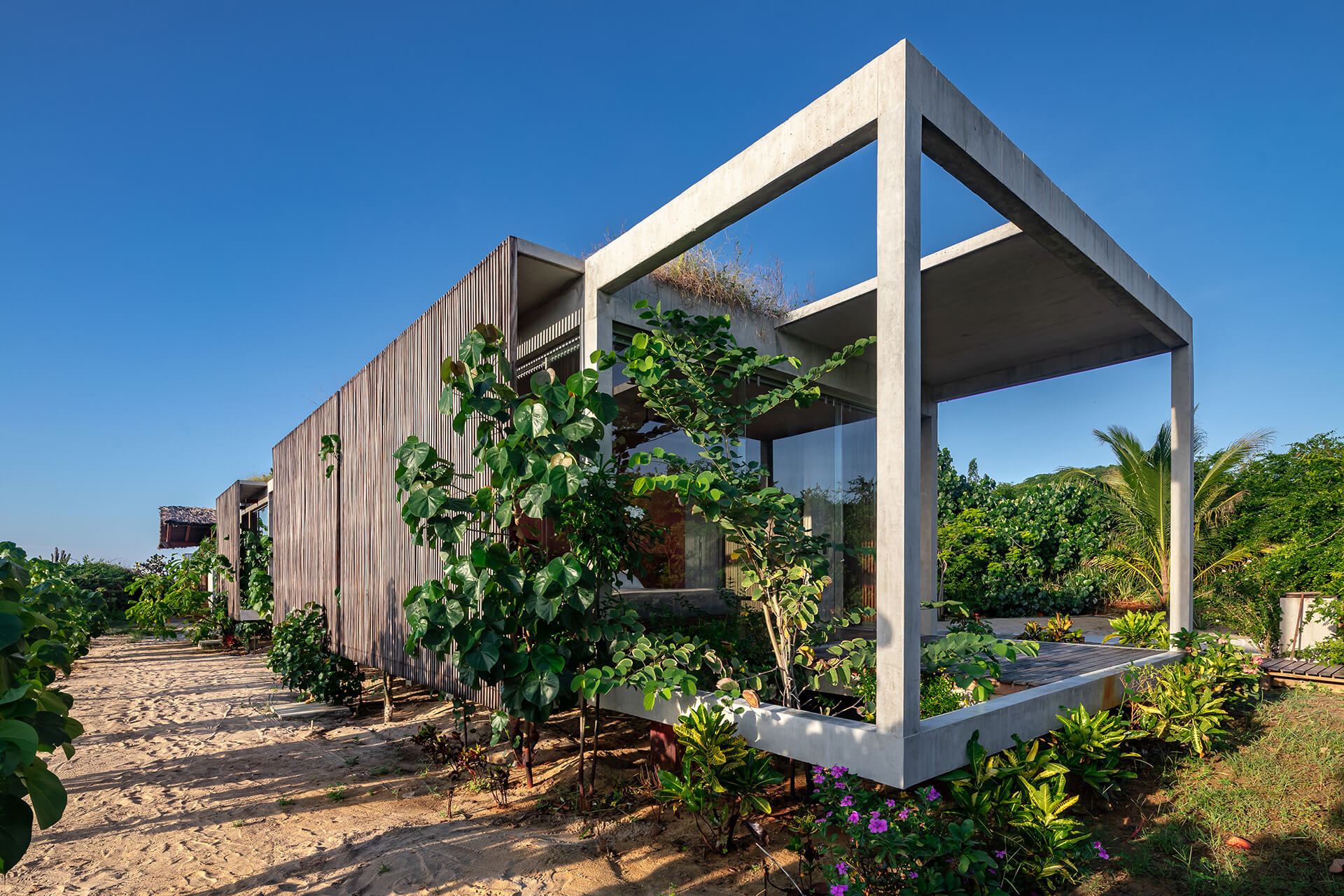The understated and modern Casa El Pinar in Mexico revels in material authenticity
by STIRworldJan 04, 2023
•make your fridays matter with a well-read weekend
by Jincy IypePublished on : May 04, 2022
Manifesting the daily, resilient and immediate, Casa Malandra conceived by Mexican firm Taller Alberto Calleja grows unhurried amid lush fields of Puerto Escondido in Mexico, defined by its intended ordinariness. Two rectangular volumes converge at their centre to perform the configuration and dynamics of the typical courtyard house, which grows with and contains part of the existing vegetation, the latter treated as yet another extension of the residential architecture, succinctly embracing the beautiful natural context. “As a concept, we decided to design spaces with free endemic vegetation that invades it, to make a wholly natural environment. We like to call these “magical spaces”, the Mexican architects share.
Configured in shape and orientation in response to the property’s views, Casa Malandra is primarily built with locally available materials – facades of wood and walls of concrete which are decorated on the exterior with wooden latticework. Both volumes find connection by means of a striking pergola that makes the structure seem permeable, filtering light from the courtyard. On its longer sides, the house extends itself toward the sea and the mountain, to set a tangible dialogue with its territory and existing vernacular architecture. A natural mirror of water was incorporated into the dwelling to “generate a new microclimate for the site”.

Articulating the private client’s wishes, architect Alberto Calleja, founder of Taller Alberto Calleja (TAC), says that they wanted a place where he could “enjoy and reunite his family and friends away from the bustle of the city and relax by connecting with a warm nature context like the beaches of Puerto Escondido. As formal petitions, he asked for patios and social spaces like a terrace and a pool that encourage coexistence. He also wanted a naturally ventilated house with ample spaces and easy circulation.”

Both forms and their adjoining transient spaces correspond directly to the needs and functions of the project, separating common and private areas through the chosen palette of shapes and materials. The sturdy, apparent concrete “seeks to narrate the time and history of the house through its ageing that will gradually show. The wood is then able to counteract the stereotomy of the concrete and provides quality, lightness, and gives a more "natural" sense to the project,” says Calleja. “If we talk about the house’s morphology, it combines the pureness of orthogonal volumes and the organic shapes from the existing vegetation at the patios as well as the natural context,” he adds.
One of the heavily wooden forms draws inspiration from the Mexican Palapa, a traditional shelter roofed by palm leaves or branches, the inspiration laid quite apparent and simple. The social areas remain concentrated and protected by this structure, with the glittering pool as company on its briefer side, and establishing an extension of the main room towards the sea; "its morphology is consistent with the neighbouring houses, providing continuity to the immediate context of the place," says Calleja. The bedrooms resolve themselves quietly within each volume, and between them lie the “magical” meeting and informal places, that express and interrelate with the circulatory routes of the residential design.
TAC, across all their works, are on a course of striking a balance between materials and what they seek to convey, in the most honest, simplest yet robust way possible. "For Casa Malandra, the common areas of the house are converged by warm and light materials like wood and palm leaves, which transmit a sense of vernacular architecture along with providing freshness to the project. Meanwhile, the private spaces are made of concrete to evoke privacy," explains the design team.
To minimise the impact of the construction, Taller Alberto Calleja insisted on protecting all the existing vegetation on site within a temporary greenhouse. This was then later transplanted to the roofs, giving them back their space. In tandem with providing a relaxing space for visitors, these green roofs further the positive impact on the natural climate control established by the 350 sqm home.
In its naturalness and lack of forced spectacle, Casa Malandra is strengthened and made distinct in its powerful realism, that nods to its age-old, traditional Mexican roots and ropes in elements of the modern in its being.
by Anushka Sharma Oct 06, 2025
An exploration of how historic wisdom can enrich contemporary living, the Chinese designer transforms a former Suzhou courtyard into a poetic retreat.
by Bansari Paghdar Sep 25, 2025
Middle East Archive’s photobook Not Here Not There by Charbel AlKhoury features uncanny but surreal visuals of Lebanon amidst instability and political unrest between 2019 and 2021.
by Aarthi Mohan Sep 24, 2025
An exhibition by Ab Rogers at Sir John Soane’s Museum, London, retraced five decades of the celebrated architect’s design tenets that treated buildings as campaigns for change.
by Bansari Paghdar Sep 23, 2025
The hauntingly beautiful Bunker B-S 10 features austere utilitarian interventions that complement its militarily redundant concrete shell.
 surprise me!
surprise me!
make your fridays matter
SUBSCRIBEEnter your details to sign in
Don’t have an account?
Sign upOr you can sign in with
a single account for all
STIR platforms
All your bookmarks will be available across all your devices.
Stay STIRred
Already have an account?
Sign inOr you can sign up with
Tap on things that interests you.
Select the Conversation Category you would like to watch
Please enter your details and click submit.
Enter the 6-digit code sent at
Verification link sent to check your inbox or spam folder to complete sign up process



by Jincy Iype | Published on : May 04, 2022
What do you think?